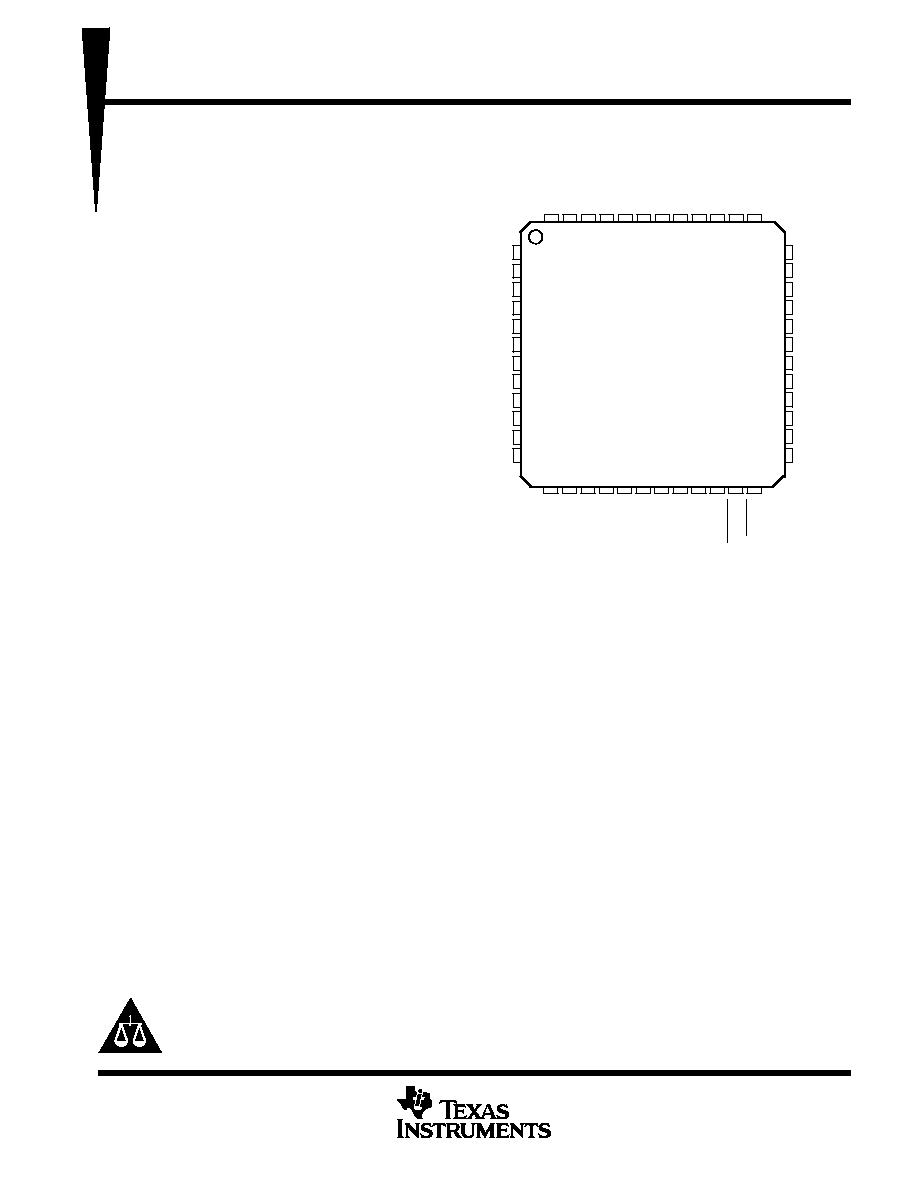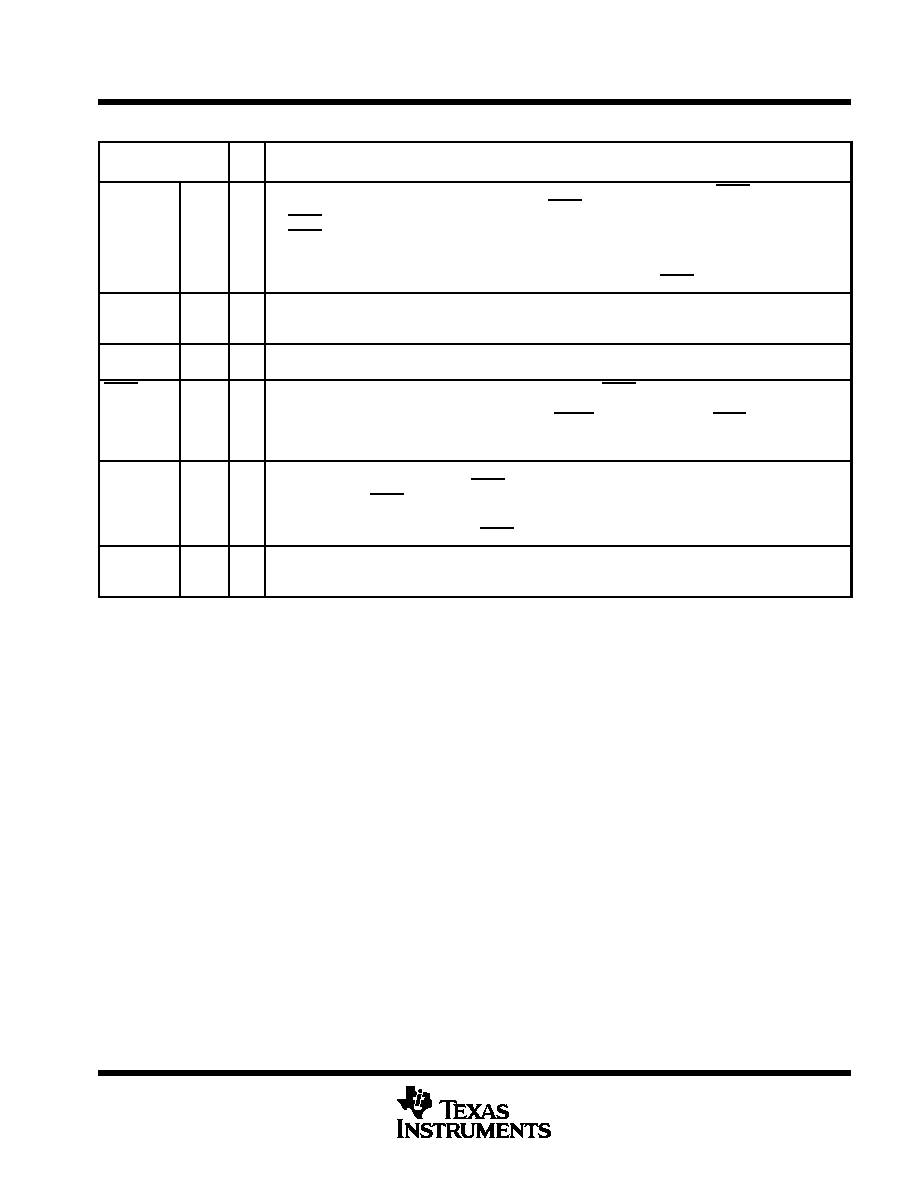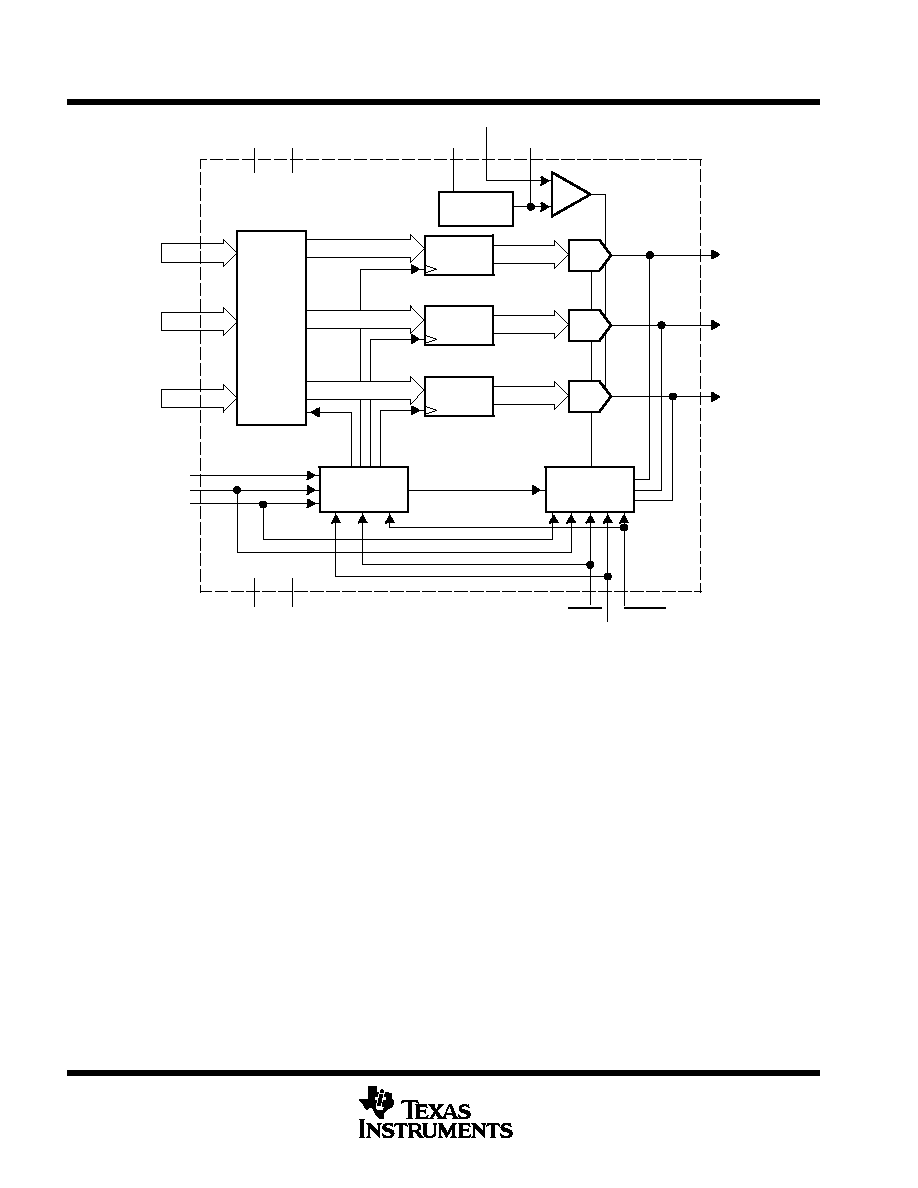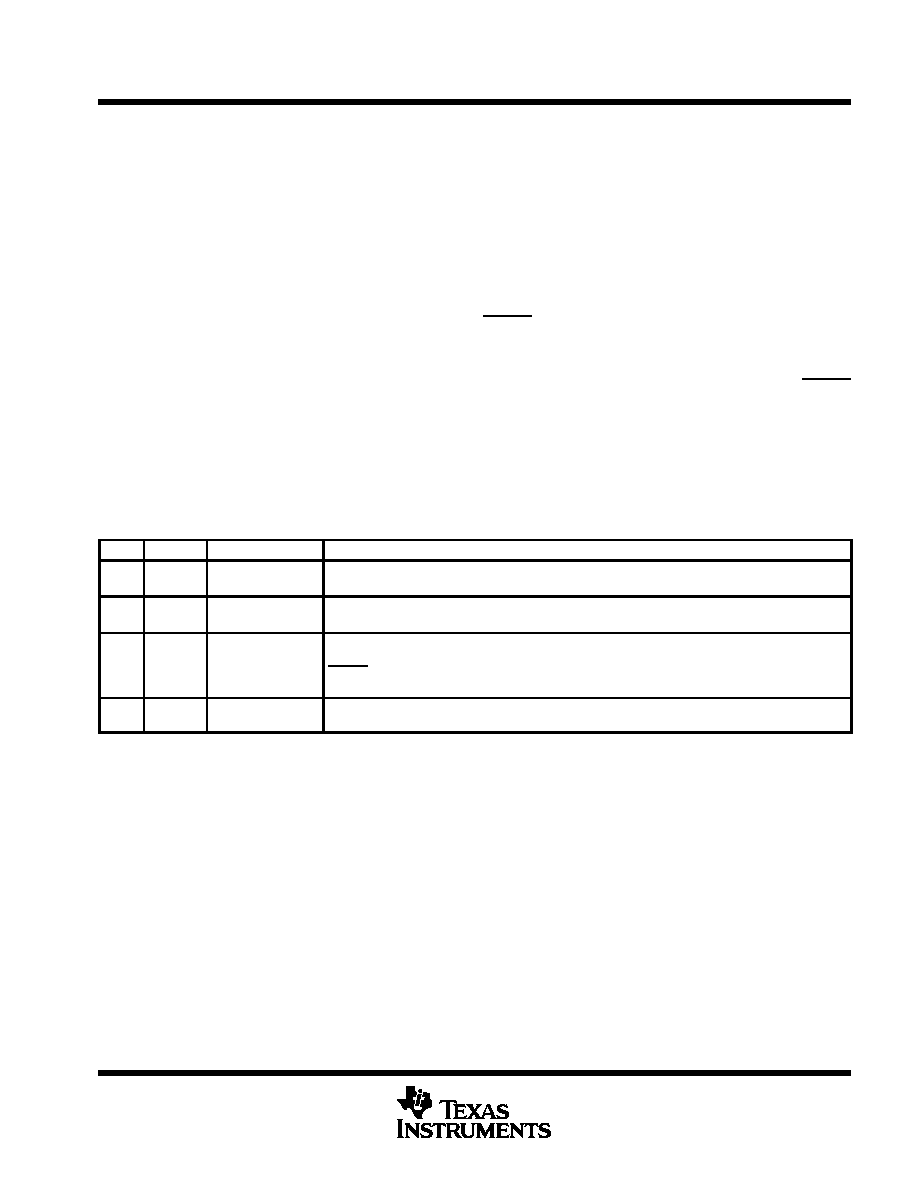 | –≠–ª–µ–∫—Ç—Ä–æ–Ω–Ω—ã–π –∫–æ–º–ø–æ–Ω–µ–Ω—Ç: THS8134 | –°–∫–∞—á–∞—Ç—å:  PDF PDF  ZIP ZIP |

THS8134, THS8134A, THS8134B
TRIPLE 8-BIT, 80 MSPS VIDEO D/A CONVERTER
WITH TRI-LEVEL SYNC GENERATION
SLVS205D ≠ MAY 1999 ≠ REVISED MARCH 2000
1
POST OFFICE BOX 655303
∑
DALLAS, TEXAS 75265
features
D
Triple 8-Bit D/A Converters
D
Minimum 80 MSPS Operation
D
Direct Drive of Doubly-Terminated 75-
Load Into Standard Video Levels
D
3
◊
8 Bit 4:4:4, 2
◊
8 Bit 4:2:2 or 1
◊
8 Bit 4:2:2
(ITU-BT.656) Multiplexed YPbPr/GBR Input
Modes
D
Bi-Level (EIA) or Tri-Level (SMPTE) Sync
Generation With 7:3 Video/Sync Ratio
D
Integrated Insertion of Sync-On-Green/
Luminance or Sync-On-All Channels
D
Configurable Blanking Level
D
Internal Voltage Reference
applications
D
High-Definition Television (HDTV) Set-Top
Boxes/Receivers
D
High-Resolution Image Processing
D
Desktop Publishing
D
Direct Digital Synthesis/I-Q Modulation
See ALSO: THS8133 (10 bit, pin-compatible)
description
The THS8134 is a general-purpose triple high-speed D/A converter (DAC) optimized for use in video/graphics
applications. The device operates from a 5-V analog supply and a 3-V to 5-V range digital supply. The THS8134
has a sampling rate up to 80 MSPS. The device consists of three 8-bit D/A converters and additional circuitry
for bi-level/tri-level sync and blanking level generation in video applications.
THS8134 is also well-suited in applications where multiple well-matched and synchronously operating DACs
are needed; for example, I-Q modulation and direct-digital synthesis in communications equipment.
The current-steering DACs can be directly terminated in resistive loads to produce voltage outputs. The device
provides a flexible configuration of maximum output current drive. Its output drivers are specifically designed
to produce standard video output levels when directly connected to a single-ended doubly-terminated 75
coaxial cable. Full-scale video/sync is generated in a 7:3 ratio, compliant with SMPTE standards for GBR and
YPbPr signals.
Furthermore, the THS8134 can generate both a traditional bi-level sync or a tri-level sync signal, as per the
SMPTE standards, via a digital control interface. The sync signal is inserted on one of the analog output
channels (sync-on-green/luminance) or on all output channels. Also, a blanking control signal sets the outputs
to defined levels during the nonactive video window.
The position of this defined (blanking) level and the temperature range, over which the maximum imbalance
between the inserted analog syncs (K
IMBAL(SYNC)
), are the only differences between the unrev, revA, and revB
device versions. Refer to the Available Options table.
Copyright
©
2000, Texas Instruments Incorporated
PRODUCTION DATA information is current as of publication date.
Products conform to specifications per the terms of Texas Instruments
standard warranty. Production processing does not necessarily include
testing of all parameters.
Please be aware that an important notice concerning availability, standard warranty, and use in critical applications of
Texas Instruments semiconductor products and disclaimers thereto appears at the end of this data sheet.
14 15
NC
NC
GY0
GY1
GY2
GY3
GY4
GY5
GY6
GY7
CLK
SYNC_T
36
35
34
33
32
31
30
29
28
27
26
25
16
1
2
3
4
5
6
7
8
9
10
11
12
BPb7
BPb6
BPb5
BPb4
BPb3
BPb2
BPb1
BPb0
NC
NC
DV
SS
DV
DD
17 18 19 20
AGY
AV
COMP
FSADJ
47 46 45 44 43
48
42
M2
M1
AV
ABPb
AV
RPr7
BLANK
SYNC
RPr0
RPr2
RPr3
RPr4
RPr5
RPr6
40 39 38
41
21 22 23 24
37
13
V
ARPr
AV
NC
NC
RPr1
TQFP-48 PowerPAD
TM
PACKAGE
(TOP VIEW)
SS
DD
SS
DD
REF
PowerPAD is a trademark of Texas Instruments.

THS8134, THS8134A, THS8134B
TRIPLE 8-BIT, 80 MSPS VIDEO D/A CONVERTER
WITH TRI-LEVEL SYNC GENERATION
SLVS205D ≠ MAY 1999 ≠ REVISED MARCH 2000
2
POST OFFICE BOX 655303
∑
DALLAS, TEXAS 75265
description (continued)
Finally the input format can be either 3
◊
8 bit 4:4:4, 2
◊
8 bit 4:2:2, or 1
◊
8 bit 4:2:2. This enables a direct interface
to a wide range of video DSP/ASICs including parts generating ITU-BT.656 formatted output data.
AVAILABLE OPTIONS
TA
PACKAGE
TA
TQFP-48 PowerPAD
THS8134CPHP
0
∞
C to 70
∞
C
THS8134ACPHP
THS8134BCPHP
In the THS8134CPHP, the KIMBALmaximum specification is
assured over full temperature range and the KIMBAL(SYNC)
maximum specification is assured at 25
∞
C. The position of
the blanking level is as shown in Table 1.
In the THS8134ACPHP and the THS8134BCPHP, both the
KIMBALmaximum specification and the KIMBAL(SYNC)
maximum specification are assured over the full temperature
range. The position of the blanking level is as shown in
Table 1.
Terminal Functions
TERMINAL
I/O
DESCRIPTION
NAME
PIN
I/O
DESCRIPTION
ABPb
45
O
Analog red, green and blue respectively Pr, Y and Pb current outputs, capable of directly driving a doubly
AGY
41
O
terminated 75-
coaxial cable.
ARPr
43
O
AVDD
40,44
I
Analog power supply (5 V
±
10%). All AVDD terminals must be connected.
AVSS
42,46
I
Analog ground
BLANK
23
I
Blanking control input, active low. A rising edge on CLK latches BLANK. When asserted, the ARPr, AGY and
ABPb outputs are driven to the blanking level, irrespective of the value on the data inputs. SYNC takes
precedence over BLANK, so asserting SYNC (low) while BLANK is active (low) will result in sync generation.
BPb0≠BPb7
8≠1
I
Blue or Pb pixel data input bus. Index 0 denotes the least significant bit. Refer to functional description for
different operating modes.
CLK
26
I
Clock input. A rising edge on CLK latches RPr0-7, GY0-7, BPb0-7, BLANK, SYNC, and SYNC_T. The M2 input is
latched by a rising edge on CLK also, but only when additional conditions are satisfied, as explained in its
terminal description.
COMP
39
O
Compensation terminal. A 0.1
µ
F capacitor must be connected between COMP and AVDD.
DVDD
12
I
Digital power supply (3-V to 5-V range)
DVSS
11
I
Digital ground
FSADJ
38
I
Full-scale adjust control. The full-scale current drive on each of the output channels is determined by the value of
a resistor RFS connected between this terminal and AVSS. The nominal value of RFS is 430
, corresponding to
26.67 mA full-scale current. The relationship between RFS and the full-scale current level for each operation
mode is explained in the functional description.
GY0≠GY7
34≠27
I
Green or Y pixel data input bus. Index 0 denotes the least significant bit. Refer to functional description for
different operating modes.
M1
47
I
Operation mode control 1. M1 is directly interpreted by the device (it is not latched by CLK). M1 configures device
according to Table 1.

THS8134, THS8134A, THS8134B
TRIPLE 8-BIT, 80 MSPS VIDEO D/A CONVERTER
WITH TRI-LEVEL SYNC GENERATION
SLVS205D ≠ MAY 1999 ≠ REVISED MARCH 2000
3
POST OFFICE BOX 655303
∑
DALLAS, TEXAS 75265
Terminal Functions (Continued)
TERMINAL
I/O
DESCRIPTION
NAME
PIN
I/O
DESCRIPTION
M2
48
I
Operation mode control 2. The second rising edge on CLK after a transition on SYNC latches M2. The
interpretation is dependent on the polarity of the last SYNC transition:
SYNC L to H: latched as M2_INT
SYNC H to L: latched as INS3_INT
Together with M1, M2_INT configures the device as shown in Table 1. When INS3_INT is high, the sync output is
inserted on all DAC outputs; a low will insert it only on the AGY output. See also Figure 2 and Table 2. The value of
M2 at power-up is undetermined. Therefore at least 1 L
H transition on SYNC is required to set M2.
NC
9, 10,
13, 14,
35, 36
Not connected
RPr0≠RPr7
15≠22
I
Red or Pr pixel data input bus. Index 0 denotes the least significant bit. Refer to functional description for different
operating modes.
SYNC
24
I
Sync control input, active low. A rising edge on CLK latches SYNC. When asserted, only the AGY output
(INS3_INT=L, see terminal M2) or ARPr, AGY and ABPb outputs (INS3_INT=H, see terminal M2) are driven to
the sync level, irrespective of the values on the data or BLANK inputs. Consequently, SYNC should remain low
for the whole duration of sync, which is in the case of a tri-level sync both the negative and positive portion (see
Figure 7).
SYNC_T
25
I
Sync tri-level control, active high. A rising edge on CLK latches SYNC_T. When asserted, a positive sync (higher
than blanking level) is generated when SYNC is low. When disabled, a negative sync (lower than blanking level)
is generated when SYNC is low. When generating a tri-level (negative-to-positive) sync, a L
H transition on
this signal positions the start of the positive transition. See Figure 6 for timing control.
The value on SYNC_T is ignored when SYNC is not asserted (high).
VREF
37
I/O
Voltage reference for DACs. An internal voltage reference of nominally 1.35 V is provided, which requires an
external 0.1
µ
F ceramic capacitor between VREF and AVSS. However, the internal reference can be overdriven
by an externally supplied reference voltage.

THS8134, THS8134A, THS8134B
TRIPLE 8-BIT, 80 MSPS VIDEO D/A CONVERTER
WITH TRI-LEVEL SYNC GENERATION
SLVS205D ≠ MAY 1999 ≠ REVISED MARCH 2000
4
POST OFFICE BOX 655303
∑
DALLAS, TEXAS 75265
R/Pr
Register
ARPr
RPr[7:0]
DAC
G/Y
Register
B/Pb
Register
DAC
DAC
DVDD
Configuration
Control
SYNC/BLANK
Control
Bandgap
Reference
GY[7:0]
BPb[7:0]
CLK
M1
M2
AGY
ABPb
DVSS
COMP
VREF
AVDD AVSS
SYNC
BLANK
FSADJ
SYNC_T
Input
Formatter
Figure 1. THS8134 Block Diagram

THS8134, THS8134A, THS8134B
TRIPLE 8-BIT, 80 MSPS VIDEO D/A CONVERTER
WITH TRI-LEVEL SYNC GENERATION
SLVS205D ≠ MAY 1999 ≠ REVISED MARCH 2000
5
POST OFFICE BOX 655303
∑
DALLAS, TEXAS 75265
functional description
device configuration
Input data to the device can be supplied from a 3x8b GBR/YPbPr input port. If the device is configured to take
data from all three channels, the data is clocked in at each rising edge of CLK. All three DACs operate at the
full clock speed of CLK.
In the case of 4:2:2 sampled data (for YPbPr) the device can be fed over either a 2x8 bit or 1x8 bit multiplexed
input port. An internal demultiplexer will route input samples to the appropriate DAC: Y at the rate of CLK, Pb
and Pr each at the rate of one-half CLK.
According to ITU-BT.656, the sample sequence is Pb-Y-Pr over a 1x8 bit interface (Y-port). The sample
sequence starts at the first rising edge of CLK after BLANK has been taken high (inactive). In this case the
frequency of CLK is two times the Y conversion speed and four times the conversion speed of both Pr and Pb.
With a 2x8 bit input interface, both the Y-port and the Pr-port are sampled on every CLK rising edge. The Pr-port
carries the sample sequence Pb-Pr. The sample sequence starts at the first rising edge of CLK after BLANK
has been taken high (inactive). In this case the frequency of CLK is equal to the conversion speed of Y and 2x
the conversion speed of both Pr and Pb.
The device's operation mode is set by the M1 and M2 mode selection terminals, according to Table 1. The
operation mode also determines the blanking level, as explained below in the sync/blanking generation
sections.
Table 1. THS8134 Configuration
M1
M2_INT
CONFIGURATION
DESCRIPTION
L
L
GBR
3x8b≠4:4:4
GBR mode 4:4:4. Data clocked in on each rising edge of CLK from G, B, and R input channels. For the
definition of the analog output levels during blanking, see note 1.
L
H
YPbPr
3x8b≠4:4:4
YPbPr mode 4:4:4. Data clocked in on each rising edge of CLK from Y, Pb and Pr input channels. For
the definition of the analog output levels during blanking, see note 1.
H
L
YPbPr
2x8b≠4:2:2
YPbPr mode 4:2:2 2x8 bit. Data clocked in on each rising edge of CLK from Y & Pr input channels. A
sample sequence of Pb≠Pr≠... should be applied to the Pr port. At the first rising edge of CLK after
BLANK is taken high, Pb should be present on this port. For the definition of the analog output levels
during blanking, see note 1.
H
H
YPbPr
1x8b≠4:2:2
YPbPr mode 4:2:2 1x8 bit (ITU-BT.656 compliant). Data clocked in on each rising edge of CLK from Y
input channel. For the definition of the analog output levels during blanking, see note 1.
NOTE 1: In all device versions, the blanking level on the AGY channel output corresponds to input code 0 of the DAC.
∑
In the THS8134CPHP and the THS8134ACPHP versions, the blanking level on the ABPb and ARPr channel outputs corresponds
to the 128 input code of the DAC, when sync is inserted on all three channels (INS3_INT=H), and to the 0 input code of the DAC,
when sync is only inserted on the Y channel (INS3_INT=L).
∑
In the THS8134BCPHP version, the blanking level on the ABPb and ARPr channel outputs corresponds to the 128 input code of
the DAC irrespective if sync is inserted on all three channels (INS3_INT=H), or if sync is inserted only on the Y channel
(INS3_INT=L).




